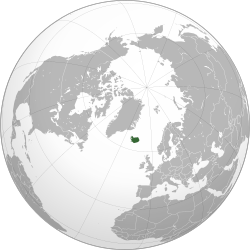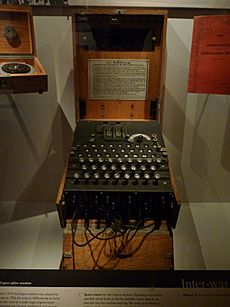Operation FB facts for kids
Quick facts for kids Operation FB |
|||||||
|---|---|---|---|---|---|---|---|
| Part of The Arctic Convoys of the Second World War | |||||||
 Iceland, western start and terminus of reciprocal sailings to and from Murmansk |
|||||||
|
|||||||
| Belligerents | |||||||
| Allies | Axis powers (Nazi Germany) | ||||||
| Commanders and leaders | |||||||
| John Tovey Arseniy Golovko |
Erich Raeder | ||||||
| Units involved | |||||||
| Royal Navy Soviet Navy RAF Coastal Command Soviet Air Defence Forces Merchant Navy United States Merchant Marine merchant ships from Allied and neutral nations |
Luftwaffe Kriegsmarine |
||||||
| Strength | |||||||
| Eastbound: 13 merchant ships escorts (west): 4 anti-submarine trawlers escorts (east): 3 trawlers |
|||||||
| Casualties and losses | |||||||
| Sunk: 5 Wrecked: 1 Recalled: 3 |
|||||||
| 23 Soviet independent sailings 29 October 1942 – 24 January 1943, 1 sunk | |||||||
Operation FB was a series of important ship journeys during the Second World War. It happened from October 29 to November 9, 1942. This operation was part of the Arctic Convoys, which were groups of ships carrying supplies.
During Operation FB, individual merchant ships sailed on their own. They traveled between Iceland and Murmansk in the Arctic Ocean. These ships did not have a military escort protecting them.
In late 1942, the Allies were fighting hard against Germany. However, sending supplies to the USSR (Soviet Union) by the Arctic route was stopped. This was because many warships were needed for a big operation in the Mediterranean Sea called Operation Torch.
To make up for the stopped convoys, leaders decided to send ships independently. They hoped the constant darkness of the Arctic winter, known as the polar night, would hide the ships. Rescue ships were also placed along the routes to help if needed.
Out of 13 ships that sailed to Russia, three were told to turn back. Five ships successfully reached their destination. From the Soviet Union, 23 ships left independently, and 22 of them arrived safely.
Contents
Background to Operation FB
Arctic Convoys: Supplying the Soviet Union
In October 1941, Germany invaded the Soviet Union. This was called Operation Barbarossa. The British Prime Minister, Winston Churchill, promised to send many supplies to the USSR. These supplies included tanks and aircraft.
The first convoys were planned to arrive in Murmansk. Ships from Britain, the Allies, and neutral countries gathered in Iceland. They were loaded with military supplies and raw materials for the Soviet war effort.
By late 1941, a system for convoys was set up. A "convoy commodore" was in charge of each group of ships. This person made sure all ship captains knew the plan. They used flags and lamps to send secret messages.
However, the Arctic convoys faced many dangers. German U-boats (submarines) and aircraft often attacked them.
Why Convoys Stopped: Operation Torch
After heavy losses in Convoy PQ 18 in September 1942, things changed. A very large operation called Operation Torch was planned for the Mediterranean Sea. This operation needed more than 500 ships to be protected.
Because of this, many British warships were sent south. The United States and Britain decided to stop the Arctic convoys for a while. The US President, Franklin D. Roosevelt, wanted to send more convoys. But the British said it would delay Operation Torch.
The Soviet Union was very unhappy about this. Their forces were fighting the Battle of Stalingrad, a huge battle on the Eastern Front. They felt the British reasons for stopping the convoys were not good enough.
Secret Information: Code-Breaking
During the war, both sides tried to break each other's secret codes. The British had a special place called Bletchley Park. Here, experts worked to read German messages.
By 1941, they could often read messages from German ships and U-boats. This included messages from the German Enigma machine. This secret information was called Ultra. It helped the Allies know what the Germans were planning.
The Germans also had their own code-breaking service called B-Dienst. They were able to read some British naval codes. This helped German ships avoid British forces and plan surprise attacks.
Planning Operation FB
The Convoy Break: Independent Sailings
In the Arctic autumn, the days became very short. By midwinter, it was almost dark all day. This darkness could help ships hide from German planes and U-boats.
Many ships from Convoy PQ 18 were still in Soviet ports. They needed to return home. Also, 40 ships were ready to sail to the USSR in Convoy PQ 19. But this convoy was cancelled.
So, the idea of ships sailing alone became popular. A British ship owner even offered extra money to sailors who volunteered. The Soviet Union also asked for two of their ships in Iceland to sail back home alone.
Two Soviet ships, Frederich Engels and Belomorkanal, sailed independently and reached their destination. This made everyone more hopeful. British leaders felt that slower merchant ships could also make the journey in the long Arctic nights.
German Forces in the Arctic
The German navy and air force were also active in the Arctic. The German cruiser Admiral Hipper and its destroyers sometimes went on missions to lay mines.
The Germans hoped to attack Allied convoys when many British warships were away. However, bad weather often kept their ships in port.
In November, the main German air command in Norway was ordered to send its bombers to the Mediterranean. This was to fight against Operation Torch. The British knew about this thanks to their secret code-breaking (Ultra). This meant fewer German bombers were left in the Arctic. Only some reconnaissance planes and a few torpedo planes remained.
Operation FB in Action
First Sailings: October 29 – November 2, 1942
| USSR | To | From |
|---|---|---|
| Sailed | 13 | 23 |
| Turned back |
3 | nil |
| Sunk | 4 | 1 |
| Wrecks | 1 | nil |
| Arrived | 5 | 22 |
The first ships of Operation FB sailed on October 29. These included SS Richard H. Alvey and Empire Galliard. They left Iceland about 12 hours apart. British and American merchant ships took turns sailing. The Soviet ship Dekabrist also sailed.
Other ships followed in the next few days. These included SS John H. B. Latrobe, Chulmleigh, SS Hugh Williamson, Empire Sky, SS William Clark, Empire Scott, Daldorch, and Briarwood.
The ships took different routes to avoid detection. Submarines also patrolled north of Bear Island to offer some protection. Rescue trawlers were positioned along the routes to help any ships in trouble.
Losses and Arrivals: November 2, 1942 – January 24, 1943
On November 2, the ship Empire Gilbert was sunk by a German U-boat, U-586, near Iceland.
On November 4, German reconnaissance planes spotted more ships. German bombers attacked. The Soviet ship Dekabrist was bombed and sunk. The ships Chulmleigh and SS William Clark were damaged. SS William Clark was later sunk by another U-boat, U-354.
On November 5, a British plane spotted and sank U-408 north of Iceland.
The damaged Chulmleigh ran aground on Sørkapp (South Cape) of Spitzbergen. It was abandoned and later sunk by a U-boat. Its crew had a very difficult six weeks on Spitzbergen before being rescued.
On November 6, U-625 sank Empire Sky, and everyone on board was lost.
In the end, five British and US ships reached Russia. Five Soviet ships sailing from Murmansk reached Iceland. With later sailings, 22 Soviet ships arrived safely. However, the Soviet tanker Donbass was sunk by a German destroyer on November 7.
Return Convoy: QP 15
Convoy QP 15 was a group of 30 empty merchant ships returning from the USSR. It was the last convoy in its series. The ships sailed from Archangel on November 17.
The convoy had some local escorts and a close escort of smaller warships. Soviet destroyers also joined for part of the journey. British cruisers and destroyers were positioned further west to protect them. Submarines were also sent to patrol near Altenfjord to deter German surface ships.
On November 20, a strong gale (storm) hit the convoy. The ships were scattered in the constant darkness of the Arctic winter. The Soviet destroyer Baku was badly damaged but made it back to port. Another Soviet destroyer, Sokrushitelny, had its stern ripped off by a huge wave and sank.
German planes and ships stayed in port because of the terrible weather. This was good news for the convoy. Three Soviet destroyers rescued 187 crew members from Sokrushitelny.
On November 23, the U-boat U-625 sank the British freighter Goolistan. Later that day, U-601 sank the Soviet freighter Kuznets Lesov. Both ships were lost with all hands.
The remaining merchant ships regrouped and arrived in Loch Ewe in Scotland in late November and early December.
Ships Involved in Operation FB
Eastbound Sailings to the USSR
| Name | Flag | GRT | Sailed | Notes |
|---|---|---|---|---|
| Briarwood | UK | 4,019 | 4 November | To USSR |
| Daldorch | UK | 5,571 | 3 November | |
| SS John H. B. Latrobe | US | 7,176 | 31 October | |
| Empire Gilbert | UK | 6,640 | 30 October | Sunk by U-586 |
| SS Dekabrist | USSR | 7,363 | 30 October | Bombed and sunk by I/KG 30 |
| SS William Clark | US | 7,167 | 2 November | Bombed by II/KG 30, sunk by U-354 |
| Empire Sky | UK | 7,445 | 1 November | Sunk by U-625 |
| Chulmleigh | UK | 5,445 | 31 October | Grounded South Cape, Spitzbergen, abandoned, bombed by II/KG 30; torpedoed and bombarded by U-625 16 November |
| SS John Walker | US | 7,176 | 30 October | |
| SS Richard H. Alvey | US | 7,176 | 29 October | |
| SS Hugh Williamson | US | 7,176 | 1 November | |
| Empire Scott | UK | 6,150 | 2 November | |
| Empire Galliard | UK | 7,170 | 29 October |
Soviet Independent Sailings
| Name | Sailed | Arrived | Notes |
|---|---|---|---|
| Mussoviet | 29 October | 7 November | Eastbound to USSR |
| Azerbaijan | 31 October | 9 November | |
| Chernyshevsky | 2 November | 11 November | |
| Donbass | 4 November | 7 November | Sunk 7 November by German destroyer Z27 |
| Komsomolets Arctiki | 14 November | 24 November | |
| Dvina | 24 November | 5 December | |
| Mironich | 25 November | 5 December | |
| Yelina | 25 November | 5 December |
Other Independent Soviet Sailings
From October 29, 1942, to January 24, 1943, 23 ships sailed from the USSR. 22 of them arrived safely.
- Aldan
- Elna II
- Kara
- Krasnoe Znamya
- Kuzbass
- Msta
- OB
- Okhta
- Osmussaar
- Sakko
- Sheksna
- Shilka
- Soroka
- Uritski
- Vanzetti
- Vetluga
Images for kids
-
Bear island (Bjornoya) south of Spitzbergen (Svalbard)



